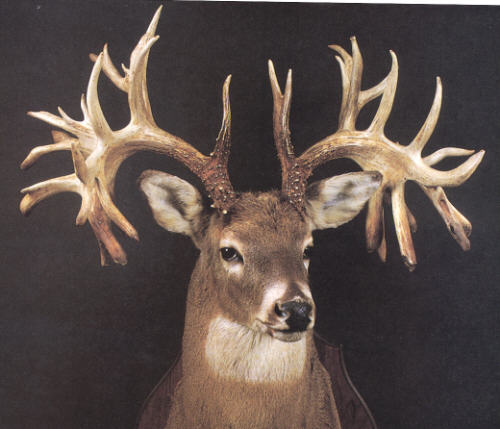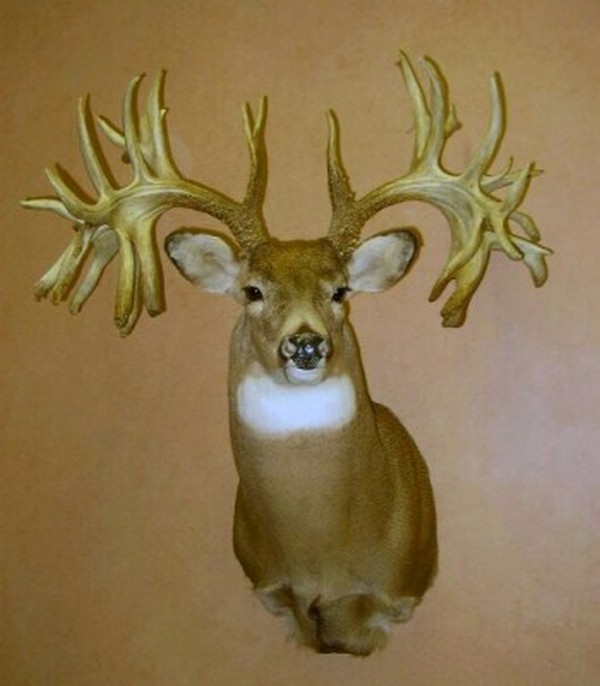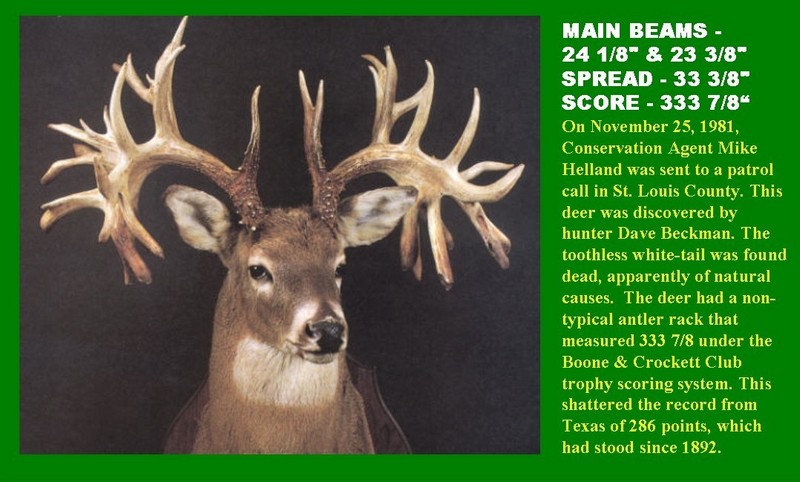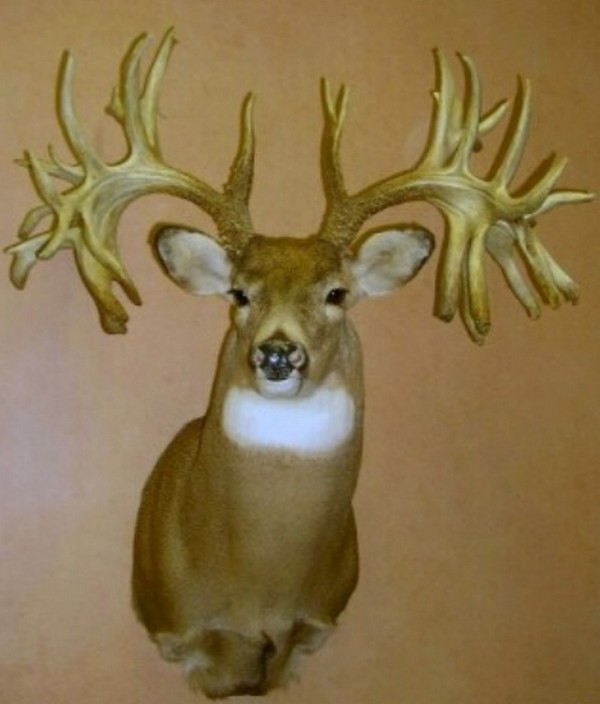The Missouri Monarch is a buck that hunters can only dream about. That is because it was not hunter-harvested, but the big white-tailed buck is the current world record non-typical white-tailed buck. Yes, that’s big! The deer was smart enough — or lucky enough — to avoid hunters despite spending it’s life in the shadows of a major metropolitan area.
The story all started on November 25, 1981, when Missouri Department of Conservation Agent Mike Helland was sent on what appeared to be a routine patrol call in St. Louis County. The white-tailed deer was discovered by a hunter, but it was not shot with bullet or arrow.

The toothless buck was found dead, apparently of natural causes. The deer had a non-typical antler rack that measured 333 7/8 under the complicated Boone and Crockett trophy scoring system. The massive antlers shattered the record from Texas of 286 points, which had stood since 1892. The buck’s antlers had an inside spread of 25 1/8 inches and weighed 11 1/4 pounds.
However, there is no definite explanation for the tremendous antler growth exhibited by the deer, but the deer grew a monstrous rack between spring and winter.
The Missouri Monarch was 4 1/2 years old and had a full-body weight of 250 pounds. The buck had a deformity in the lower jaw, causing it to be set back a few inches. According to Department biologists, the deformity may have been caused by a canine bite early in the buck’s life.
The injury consisted of a small puncture hole in the lower jaw bone that apparently resulted in an infection that caused a total loss of his lower incisor teeth.
A buck’s antlers are composed of calcium, phosphorus, and protein. When growth is completed, the once soft antlers forms into solid bone. Abnormally shaped antlers occur occasionally, for several reasons, and sometimes represent injury during growth.
The big Missouri buck represents the trophy that most deer hunters dream of, but it goes into the books as a deer “not taken by a hunter.” What a story.



That is one cool looking buck!
This is one sweet looking deer, and has a great looking rack!
This buck is freaking huge! Why can’t I get a buck like this?!?
Oh dang, that’s one huge buck! Man, I wish I could kill something that big!! I mean just look at that rack on that thing.
This buck looks fake, but that’s just me. A sweet deer, though.
WOW! I have been hunting a buck in similiar size for two years running, so if you have got any tips for these monster bucks, please reply.
I have had great success using tree stands to hunt for big bucks.
Locate his bedding area, know the buck’s core area, and with a good strategy and a early arrival you just might harvest him. Seasonal timing is very crucial . Shaun from Michigan.
I have a question. There are so many weird facts with this story. This buck was “toothless,” yet weighed 250 pounds and had THAT rack?? And he was 4.5 years old and had NO TEETH? I just don’t see how this buck was THAT young, with THAT rack, weighing THAT much and had no teeth in the very early winter. It doesn’t all add up to me. If you can make any sense out of this Buckmanager I’d appreciate it.
Good question for sure Hunter D. This story is basically written as it was originally told in the press, but there are some things that do not quite add up, especially the part about being toothless. I have always suspected that the bottom jaws were missing and that the buck was not actually toothless, but I do not know this for fact.
When you get down to it, I can buy the rest of the story since Missouri can produce some big-bodied bucks—and considering this deer is a genetic anomaly to begin with—but either the age or the toothless part can not be right.
I agree with you Buckmanager. Some of the facts are incorrect. The “toothless” part is difficult to swallow since most of the deer with run-down teeth can’t eat as well, thereby having inferior antlers… which this deer does not.
Hi, I personally know this is real. Many, many years ago Mike Helland was my boyfriend and he brought it home and it lived in our freezer in the basement for a while before it went off to the taxidermist. I opened the freezer and jumped out of my skin. It was monstrous, seemed bigger than a moose rack.
Hey, why didn’t the guy that found it get to keep it? Just seems fair that if a man finds a buck and has the will and the want he should be able to keep it!
Greetings, I am only writing this to confirm that this beautiful animal really was magnificent, as I had the privilege to hunt him and I actually named him “Socrates” from the first time that I walked up on him in September of that year in a soybean field. He was still in velvet at that time.
I actually seen him alive four times and could have thrown an arrow at him twice, but turned down the not-so-perfect shots. The closet that I got to him was about 20 yards.
I contacted Mike Helland back then to get information of the MO record and told him about the buck that I was hunting.
He called me after gun season and told me that the buck had died. I later had the privilege to actually hold that beautiful rack in my hands and still have an original photo of his frozen head. I am very thankful for all of my memories and am glad that “Socrates” does not belong to anyone.
The hunter who found this buck has gotten nothing for it. He found it over a fence line on public land and reported it. The state has made millions on him. They are selling 75 bronze statues of him this month. Actually, the hunter did get a framed photograph of the buck.
The hunter that found it got royally screwed.He had a tag, was on public land, and got the shaft. If I was he, I would have been seeing an attorney. Just to learn from the hunter’s mistake, if I could ever be fortunate enough to come across something like this, my tag would be on it before a game warden would ever see it.
I work for the MDC and can clear up some questions.
1. The hunter operated legally, in that, had he claimed the deer without having actually harvested it, he would have poached it and would have lost the deer, his hunting license, and would have received a rather large fine. By calling the agent, he could have asked for a disposition form but it is up to the discretion of the agent whether or not to issue the form.
2. The “toothless” deer really means that the front teeth “incisors” were missing. The 3 pre-molars and 3 molars were still in good shape and allowed him to continue eating (and growing his impressive rack). It is from the wear on the molars that the age was able to be determined. Then a tooth was sampled to verify the age.
3. All wildlife are property of the State and it is the tags and permits that allow hunters and fishermen to harvest fish and wildlife. The actual mount and antlers are locked in a vault in Jefferson City. There are currently 9 commissioned replicas in the world (where the “It looks fake” comment comes in).
The media does twist things and misses details, but the genetic anomaly that is this buck does exist still in lesser degrees in the bucks at Columbia Bottom CA. I can personally attest to this as I have hunted out there and worked extensively with the staff there who always get reports of impressive bucks seen and harvested on the area.
Best of luck to all you hunters
I owned and operated a wildlife art gallery and custom framing shop in the Midwest back in the late 80’s and up until I moved to Florida in 2001 and I carried an artist who was very well known during that era and I am sure is still active in the wildlife art field. His name is Ron Van Gilder and he painted a limited edition collection featuring the typical and non-typical world record bucks in the Boone & Crockett and Pope & Young registries. What made his art rather unique was he would travel to the area where each one of these monster bucks were harvested and he would do a photo shoot of that area in an attempt to place his artistic version of the animal in as much of a natural background of the area in which the animal was taken as was humanly possible. In the case of the Jordan Buck, taken by Jim Jordan back early in the 20th century up in Wisconsin, Van Gilder had the added challenge of sizing the full grown trees on the river bank where the buck crossed before finally dying to represent the young saplings which had probably been there over a half century earlier!
HIs rendition of the “Missouri Giant”, the name he had given his painting of the buck in this article, was supposedly located near an old broken down hedge post fence emptying out of a wooded area into an open field.
His paintings included the buck that finally took the Boone & Crockett top spot for typical trophy rack away from the Jordan Buck. This buck was shot by Milo Hanson during this same time period and I was one of the first galleries to receive the LE art prints of the “Hanson Buck” when it was released by Wild Wings, the MN based publisher of all of Van Gilder’s prints at that time.
One question in my mind as i look at the photos in this article though, there are 4 photos of the Missouri buck in the article. Starting from the beginning of the article, photos 1 and 3 appear to be of the same reproduction of one of the head mounts. Photos 2 and 4 appear to be also of one of the reproduction head mounts. But, if you look closely at photos 2 and 4, one is a complete reversal of the other. Note the direction the mount is looking in both photos, compare the tines on each rack, you will notice that the brow tines, one forked and one single, and all the other tines on the rack are 180 degrees opposite! Somebody apparently Photoshopped the photo and flipped one of the print copies.
Now the odd thing of this all is, when Ron Van Gilder researched a specific animal or game bird, he made the image accurate right down to the number of wing feathers on a typical bird or the curve and placement of the tines on a rack of any game animal he was preparing to paint. I happen to have some colored advertising print cards of the “Missouri Giant” stored in a file cabinet. Yeah, OK, I am also a pack rat when it comes to throwing that sort of stuff out. But the brow tines on Van Gilder’s painting of this non-typical racked buck are in the same configuration as the rack in photo #2! In other words, the forked brow tine on his painting is on the right hand antler of the image of the deer. I would be surprised if Van Gilder had made such an obvious mistake at painting the rack backwards but this means that 3 of the 4 photos of the reproductions of the head mount are wrong! I no longer have Ron’s contact information or I would be placing a phone call to him tomorrow just to touch base with him after almost 20 years since my last meeting with the artist. And the first question would be “Hey, Ron, which antler was the forked brow tine on with that Missouri Giant you painted back in the day??” I may not get another good night’s sleep if I can’t sort this out in my mind!!
If anyone still attends either the MN or MI Wildlife Federation’s Wildlife Art Festivals, Ron was always a regular at both shows along with the Hautman brothers, their buddy Bruce Miller, and Marian Anderson, a dear old friend of mine and, hopefully she is still able to get around and paint her wonderful images.
Any help in clearing this up for me will lead to many more nights of restful sleep for a retired picture framer who can’t remember what he did yesterday but has a photographic memory about anything in the wildlife art field and can still back up what he says is fact with proof.
(I KNEW those ad cards would come in handy one day!!) Ha!
I would just like to say that is pretty crazy and absolutely amazing. But the guy who found the deer I think does deserves something.
I think guys should actually get the deer.
That buck belongs to whoever found him. Step aside state boy. You know that deer is not yours.
In the first picture the split brow tine is on the left instead of the right, as in the other two pictures?
Wildman 34, that’s paying attention to detail! I have never noticed that, but the photo appears to have been flipped vertically, which is difficult to tell because so many points are involved.